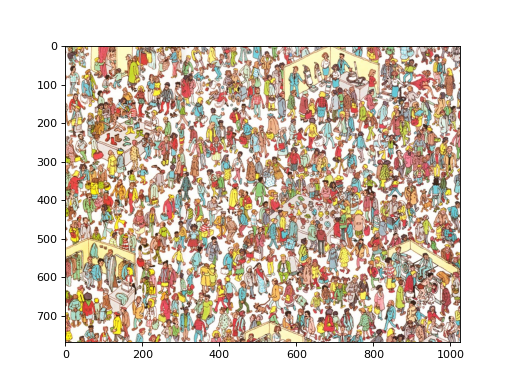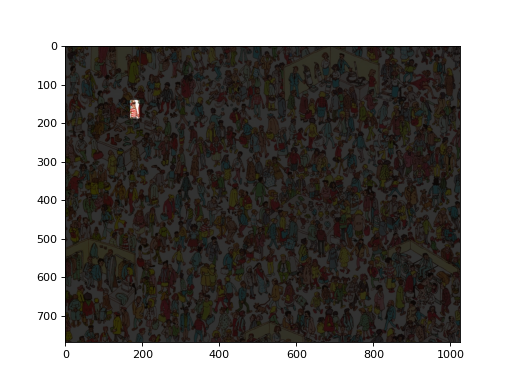Finding Wally¶
This was originally an answer on stackoverflow We can use it as a simple tutorial example.
The problem is to find Wally (who goes by Waldo in the US) in the following image:
from pylab import imshow, show
import mahotas
import mahotas.demos
wally = mahotas.demos.load('Wally')
imshow(wally)
show()
(Source code, png, hires.png, pdf)

From October 11 2013 onwards (version 1.0.4 or later), you can get the Wally image from mahotas as:
import mahotas.demos
wally = mahotas.demos.load('Wally')
Can you see him?
wfloat = wally.astype(float)
r,g,b = wfloat.transpose((2,0,1))
Split into red, green, and blue channels. It’s better to use floating point arithmetic below, so we convert at the top.
w = wfloat.mean(2)
w is the white channel.
pattern = np.ones((24,16), float)
for i in range(2):
pattern[i::4] = -1
Build up a pattern of +1,+1,-1,-1 on the vertical axis. This is Wally’s shirt.
v = mahotas.convolve(r-w, pattern)
Convolve with red minus white. This will give a strong response where the shirt is.
mask = (v == v.max())
mask = mahotas.dilate(mask, np.ones((48,24)))
Look for the maximum value and dilate it to make it visible. Now, we tone down the whole image, except the region or interest:
wally -= .8*wally * ~mask[:,:,None]
And we get the following:
wfloat = wally.astype(float)
r,g,b = wfloat.transpose((2,0,1))
w = wfloat.mean(2)
pattern = np.ones((24,16), float)
for i in range(2):
pattern[i::4] = -1
v = mahotas.convolve(r-w, pattern)
mask = (v == v.max())
mask = mahotas.dilate(mask, np.ones((48,24)))
np.subtract(wally, .8*wally * ~mask[:,:,None], out=wally, casting='unsafe')
imshow(wally)
show()
(Source code, png, hires.png, pdf)
